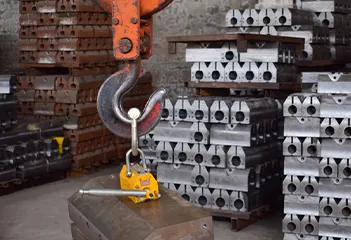Double Girder Overhead Crane Features and Benefits for Industrial Applications
Understanding Double Girder Overhead Cranes A Comprehensive Overview
Double girder overhead cranes are a critical component in modern industrial settings, providing invaluable assistance in the movement and handling of heavy loads across various applications. These cranes are distinguished by their two parallel girders, which offer enhanced stability and load capacity compared to single girder designs. This article delves into the features, advantages, applications, and maintenance considerations of double girder overhead cranes.
Features
Double girder overhead cranes are engineered for maximum efficiency and safety. The two girders provide a robust support structure that allows for the lifting of heavier loads, often exceeding capacities of up to 100 tons. The design typically features a trolley and hoist that run along the top of the girders, affording high lifting heights and clear travel paths. Additionally, double girder cranes can be designed with various features, such as radio controls, remote operation capabilities, and multiple speed options, which allow for improved operational flexibility.
Another notable characteristic is the configuration and assembly. These cranes can be tailored to fit specific warehouse or factory layouts, maximizing the use of available space. Options for different spans and heights ensure that they can accommodate diverse load requirements and operational contexts.
Advantages
One of the primary advantages of double girder overhead cranes is their ability to handle heavier loads. The dual-girder design distributes weight more evenly, allowing for higher lifting capacities without compromising stability. This is particularly beneficial in environments like manufacturing plants, shipyards, and large warehouses, where heavy and bulky materials are frequently moved.
double girder overhead crane

Moreover, double girder cranes usually have wider spans than their single-girder counterparts, allowing for greater freedom of movement across workspaces. This enables operations to be conducted more efficiently, reducing downtime and increasing productivity. Furthermore, the overhead design ensures that ground space is kept clear, thus enhancing overall safety around the work area.
Applications
The versatility of double girder overhead cranes makes them suitable for various applications across numerous industries. Manufacturing plants often employ these cranes for the movement of raw materials and finished products. Their capacity to handle hefty loads makes them ideal for the automotive and steel industries, where components can be massive and heavy.
Warehousing and distribution centers also benefit from the use of double girder cranes. They facilitate the efficient loading and unloading of goods, optimizing storage space and improving logistical operations. In addition, construction sites often rely on these cranes for lifting materials, equipment, and even complete structures into place, showcasing their robust application in heavy-duty lifting scenarios.
Maintenance Considerations
Regular maintenance is essential to ensure the longevity and reliability of double girder overhead cranes. A well-maintained crane operates more safely and efficiently, thus reducing the risk of accidents and breakdowns. The maintenance regimen should include routine inspections of mechanical components, such as the hoist, trolley, and electrical systems. Lubrication of moving parts, checking wear and tear, and ensuring that all safety features are functional are critical steps in preserving the crane's operational integrity.
In conclusion, double girder overhead cranes are indispensable tools in modern industrial applications. Their robust design, high load capacity, and versatility cater to a wide range of needs across various sectors. By understanding their features, advantages, and maintenance requirements, businesses can maximize the effectiveness of these cranes in their operations, ensuring smooth and safe handling of heavy loads. As industries continue to evolve, the importance of efficient material handling solutions, like double girder overhead cranes, will only increase, underscoring their significance in the modern industrial landscape.
-
Unlock Seamless Relocation with Our Heavy Equipment Moving ExpertiseNewsJun.06,2025
-
Unleash Unrivaled Flexibility with Our Adjustable Gantry CraneNewsJun.06,2025
-
Unleash Heavy-Duty Efficiency with Our Industrial Gantry Crane SolutionsNewsJun.06,2025
-
Revolutionize Steel Handling with Our Magnetic Lifter RangeNewsJun.06,2025
-
Master Equipment Mobility with Premium Machinery Mover SolutionsNewsJun.06,2025
-
Elevate Your Material Handling with Magnetic Lifter TechnologyNewsJun.06,2025
-
YS Permanent Lifting Magnets: The Smarter Way to Handle SteelNewsMay.22,2025
